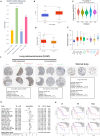Potential Role of S-Palmitoylation in Cancer Stem Cells of Lung Adenocarcinoma
- PMID: 34621750
- PMCID: PMC8490697
- DOI: 10.3389/fcell.2021.734897
Potential Role of S-Palmitoylation in Cancer Stem Cells of Lung Adenocarcinoma
Abstract
S-palmitoylation, catalyzed by a family of 23 zinc finger Asp-His-His-Cys (DHHC) domain-containing (ZDHHC) protein acyltransferases localized on the cell membrane. However, stemness genes modulated by ZDHHCs in lung adenocarcinoma (LUAD) remain to be defined. Previously, we have constructed a network of cancer stem cell genes, including INCENP, based on mRNA stemness indices (mRNAsi) of LUAD. INCENP has the function of a chromosomal passenger complex locating to centromeres, which is performed by the conserved region of its N-terminal domain. INCENP protein with a deletion of the first non-conserved 26 amino acid sequence failed to target centromeres. However, the exact function of the deleted sequence has not been elucidated. To identify novel cancer stem cell-relevant palmitoylated proteins and responsible ZDHHC enzymes in LUAD, we analyzed multi-omics data obtained from the database of The Cancer Genome Atlas (TCGA), Gene Expression Omnibus (GEO), Clinical Proteomic Tumor Analysis Consortium (CPTAC), and the Human Protein Atlas (HPA). ZDHHC5 is distinguished from the ZDHHC family for being up-regulated in mRNA and protein levels and associated with malignant prognosis. ZDHHC5 was positively associated with INCENP, and the correlation score increased with LUAD stages. CSS-Palm results showed Cys15 was the S-palmitoylation site of INCENP. Interestingly, Cys15 locates in the 1-26 aa sequence of INCENP, and is a conserved site across species. As INCENP is a nuclear protein, we predicted that the nuclear localization signal of ZDHHC5 was specific to the importin αβ pathway, and the result of immunofluorescence proves that ZDHHC5 is located in the nucleoplasm, in addition to the plasma membrane. Therefore, our study indicates the S-palmitoylation of INCENP mediated by ZDHHC5 as a potential mechanism of S-palmitoylation to modulate CSCs in LUAD.
Keywords: INCENP; S-palmitoylation; ZDHHC5; cancer stem cell; lung adenocarcinoma; mRNAsi; machine learning.
Copyright © 2021 Zhang, Li, Fu, Liu, Lien and Li.
Conflict of interest statement
I-CL was employed by the company Insight Genomics Inc. The remaining authors declare that the research was conducted in the absence of any commercial or financial relationships that could be construed as a potential conflict of interest.
Figures





Similar articles
-
Involvement of ZDHHC9 in lung adenocarcinoma: regulation of PD-L1 stability via palmitoylation.In Vitro Cell Dev Biol Anim. 2023 Mar;59(3):193-203. doi: 10.1007/s11626-023-00755-5. Epub 2023 Mar 31. In Vitro Cell Dev Biol Anim. 2023. PMID: 37002491
-
A facile assay for zDHHC palmitoyl transferase activation elucidates effects of mutation and modification.J Lipid Res. 2025 Feb;66(2):100743. doi: 10.1016/j.jlr.2025.100743. Epub 2025 Jan 10. J Lipid Res. 2025. PMID: 39800157 Free PMC article.
-
ZDHHC5-mediated S-palmitoylation of FAK promotes its membrane localization and epithelial-mesenchymal transition in glioma.Cell Commun Signal. 2024 Jan 17;22(1):46. doi: 10.1186/s12964-023-01366-z. Cell Commun Signal. 2024. PMID: 38233791 Free PMC article.
-
Local Palmitoylation Cycles and Specialized Membrane Domain Organization.Curr Top Membr. 2016;77:97-141. doi: 10.1016/bs.ctm.2015.10.003. Epub 2015 Nov 27. Curr Top Membr. 2016. PMID: 26781831 Review.
-
Research progress on S-palmitoylation modification mediated by the ZDHHC family in glioblastoma.Front Cell Dev Biol. 2024 Nov 5;12:1413708. doi: 10.3389/fcell.2024.1413708. eCollection 2024. Front Cell Dev Biol. 2024. PMID: 39563863 Free PMC article. Review.
Cited by
-
Genome-wide analyses identify 30 loci associated with obsessive-compulsive disorder.Nat Genet. 2025 Jun;57(6):1389-1401. doi: 10.1038/s41588-025-02189-z. Epub 2025 May 13. Nat Genet. 2025. PMID: 40360802 Free PMC article.
-
Restoration of Osimertinib sensitivity in lung cancer through BRD4 inhibitor-mediated depalmitoylation of mutant EGFR via APT1.NPJ Precis Oncol. 2025 Aug 28;9(1):305. doi: 10.1038/s41698-025-01048-8. NPJ Precis Oncol. 2025. PMID: 40877429 Free PMC article.
-
PRDX6: A protein bridging S-palmitoylation and diabetic neuropathy.Front Endocrinol (Lausanne). 2022 Sep 2;13:992875. doi: 10.3389/fendo.2022.992875. eCollection 2022. Front Endocrinol (Lausanne). 2022. PMID: 36120430 Free PMC article.
-
Recent advances in S-palmitoylation and its emerging roles in human diseases.J Hematol Oncol. 2025 Sep 1;18(1):83. doi: 10.1186/s13045-025-01738-7. J Hematol Oncol. 2025. PMID: 40890756 Free PMC article. Review.
-
[Research Progress and Applications of ZDHHC-mediated Protein Palmitoylation in the Development and Immune Escape of Non-small Cell Lung Cancer].Zhongguo Fei Ai Za Zhi. 2025 Apr 20;28(4):319-324. doi: 10.3779/j.issn.1009-3419.2025.102.15. Zhongguo Fei Ai Za Zhi. 2025. PMID: 40404480 Free PMC article. Review. Chinese.
References
LinkOut - more resources
Full Text Sources
Research Materials
Miscellaneous

